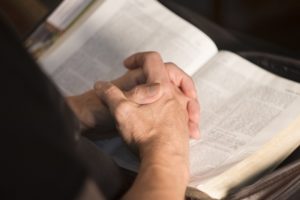Where Do I Pray?
By Jon Graf
 I remember as a young boy often seeing my parents’ bedroom door open a crack and my mother kneeling in prayer beside the bed. I somehow knew I wasn’t to disturb her there because something intimate was taking place. I later learned that this was Mom’s place to daily meet with God.
I remember as a young boy often seeing my parents’ bedroom door open a crack and my mother kneeling in prayer beside the bed. I somehow knew I wasn’t to disturb her there because something intimate was taking place. I later learned that this was Mom’s place to daily meet with God.
As I grew older, I think one of the reasons I always struggled with prayer was that I never found a special place to pray, a place many Christians dub their “prayer closet.” In the Sermon on the Mount, Jesus matter-of-factly said, “When you pray, go into your room, close the door and pray” (Matthew 6:6). The King James Version says, “Enter into thy closet,” which is where the term “prayer closet” comes from. Does that verse mean we are to remove the shoes, clothes, and boxes from one of our closets and use that space for prayer? No, the verse is not a command. Jesus was simply saying, “Don’t make a show of your prayers.”
Actually, the room Jesus was likely referring to was the storage room. Most Jewish houses of that day had two rooms—a large room for living and a storage room for food provisions. The storage room was the only room that may have had a door to keep critters out. But, while I cannot see a scriptural command to have a prayer closet, there is a profound benefit from having a specific location in which to pray.
When I worked for NavPress, my assistant, Sandie Higley, literally did clean out a three-by-six closet of shoes, clothes, and boxes, and made it her place of prayer. She wrote an article in Pray! magazine about the experience:
I began to feel God’s pleasure at having made Him a sole priority in this area of my home. I can—and do—pray anywhere. We are to pray without ceasing, which indicates an attitude of prayer throughout the day—no matter where we are. But real intimacy with God occurs when we come aside with Him to a quiet place. . . .
I feel the same sense of business with God when I enter my prayer closet. The things that otherwise distract my focus and attention are shut out instantly when I close that door. No one disturbs me there. The Father has my undivided attention, and I have His. (Quoted from “So What’s the Big Deal about a Prayer Closet?” Sandie Higley. Pray! Issue 7, July/August 1998.)
Jesus didn’t have a “closet.” But He did have a time and place to pray. Many Scriptures refer to His going away by Himself at night or early in the morning to pray. He probably found a quiet, secluded place to meet the Father. “Your ‘closet,’” said Sandie, “doesn’t literally have to be a closet. It just has to be a spot that belongs only to the two of you, a place that honors and delights the Father and gives Him the opportunity to honor and delight you in return.”
For me, a specific chair in my bedroom serves the purpose. I get a cup of coffee and my Bible, and meet God in that chair each day. My little dog, Oscar, loves to join me, curling up on my lap as I begin to read. He is so used to my routine that he often heads for the chair without me at that time of the day.
Is Location Important?
So, am I saying that you have to have a specific place in which to pray? No. But if you want to get to the maturity level where you make time for prayer every day, having a specific place helps. It provides discipline, and more importantly, it makes it easier to enter the Lord’s presence. As Sandie indicated, the things that distract your focus are not present when you have a specific place.
The key is to find a setting where you will not be interrupted. That may mean setting up a literal prayer closet. If you have the space in which to do that, I highly recommend it. Prayer warrior Dick Eastman once put a storage shed in his basement (complete with carpeted floor and walls) to serve as his prayer closet. In his current house, he built a little room under the stairs to his basement. If you set up a specific closet, you can decorate it with things that will turn your heart toward prayer—prayer lists, Scripture, world maps, photos of those for whom you regularly pray, and so on.
For most of us this will mean finding the room in our house where we are least likely to be disturbed, or where we are most comfortable. However, for some, sitting in one spot may not be conducive to disciplined praying. For you, finding a place where you can move is important. Do you know that prayerwalking is a perfectly legitimate form of praying? Take a walk and commune with God as you go. It may even help you to focus better. Perhaps some of your neighbors are on your prayer list. Thoughts of what to pray will come far more easily if you walk by their house rather than sit in your bedroom.
Remember, you can pray anywhere, at any time. Having a regular place simply makes communing with God easier.
What About Positions?
If you are having trouble staying focused while you pray, there are other things you can do as well. Perhaps changing your position from time to time would help. Scripture and other cultures provide a number of prayer positions you might try. Each has special significance. Most of the following positions and their meanings come from the article “Body Language: Praying with Your Whole Self,” by David Trembley. (Trembley quotes from “Body Language: Praying with Your Whole Self,” David Trembley. Pray! Issue 12, May/June 1999.
On your face. Praying flat on your face can suggest humility. Jesus did it in the garden on the night He was betrayed: “Going a little farther, he fell with his face to the ground and prayed” (Matthew 26:39). Lying prostrate can be an excellent position because it shows a recognition of who we are—sinners—and who God is—holy and above us. It may not be a good position if you continue to fall asleep!
On your knees. This used to be the position everyone took when in a church prayer meeting. Today it has fallen on hard times as we prefer to be more comfortable sitting in our chairs. But it too shows humility and respect. People bow before kings and we are coming into the presence of the King of kings when we pray.
With your hands lifted. Exodus 17 tells the story of the Israelites’s battle with the Amalekites. When Moses lifted his hands, the tide shifted to the Israelites; when he dropped his arms, the Amalekites started winning. Praying with your hands raised can be a symbol of victory, of praise, or of wanting to receive.
On your back. Praying while lying flat on your back can suggest wonder and willingness. It is a position of receiving.
Trembley suggests: “Try this experiment. Lie face down and attend to God’s presence. Speak and listen until you believe that the time of prayer is finished. Then roll over on your back and begin to pray again. Experience what happens to your prayers when you change positions.”
Pacing. A number of cultures pace about the room when they pray. If you are an active person, this posture might be best because it allows for an intensity in your praying.
So What?
So what does it all mean? While there are no hard and fast rules about having a place to pray, the practice clearly has benefits. If you have never done so, I recommend seeking a specific location in which to have a time of Bible reading and prayer each day. Then pick a time. If you are a morning person, set your time early. If you are a night person who needs to relax and unwind, pick a time in the evening. Prayer will become easier as it becomes more regular.
If you have tried all that and prayer still has not become more regular in your life, try prayerwalking or experimenting with various positions.
I actually began to become disciplined in my prayer life by learning to pray in the car. In 1988 and 1989, my job was thirty miles from home. I used my forty-minute commute to pray. I would often pop a worship tape in the car’s tape player as background and just meet the Lord. It really made my day. In my next job, my commute was shorter, but I still used the time to pray. On that commute I even used specific traffic lights to remind me to pray for specific things. One long light in particular used to remind me to pray for my pastor. If it was green as I approached, I would even slow down to give it time to change. An especially long light, this gave me more than three minutes to uphold my pastor each day.
The point is, experiment with location and place until you find a solution that moves you toward more regular and significant prayer.
 Jonthan Graf is the president of the Church Prayer Leaders Network. This article is taken from his book, The Power of Personal Prayer. Jon is a popular speaker on the subject of prayer, and he loves to fire up believers in local churches to pray with more passion and purpose. Contact him at jon@prayerleader.com.
Jonthan Graf is the president of the Church Prayer Leaders Network. This article is taken from his book, The Power of Personal Prayer. Jon is a popular speaker on the subject of prayer, and he loves to fire up believers in local churches to pray with more passion and purpose. Contact him at jon@prayerleader.com.
To order The Power of Personal Prayer, click the Buy Now button below.